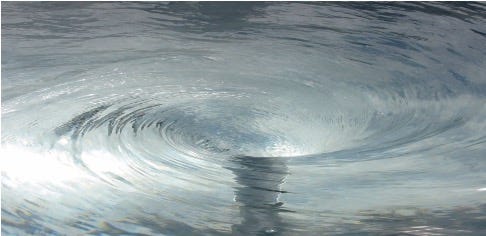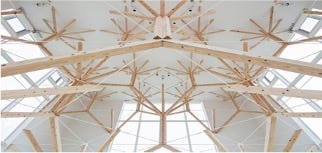🍄 #1 The Syntropocene
Hidden in Plain Sight: SyntropAg, living water, the superformula, urban fractals. Some wonderings on the the signposts we see changing the future.
From the minds of Sputnik Futures. Exploring every rabbit hole there is. For more wanderings, become an Alice in Futureland subscriber—it's free.
🍄 AudioDose: this is Alice on Sonic Mushrooms. Take an Earthcore spin here.
🎧 Solar Punk Agtech with Agam Khare, CEO & founder of Absolute
🎧 Alice in Futureland podcasts
📘 ALICE books
The syntropocene is the era of people, planet, and prosperity.
The era in which we understand that everything is related to our planet Earth. Our home. The era in which we humans will finally become an adaptive animal species and redesign our ecosystem in a healthy way.
syntropic farming
It’s very easy to say that we want to work with nature and not against it. That regeneration can be achieved from cycles and inputs, but what about interpreting nature itself? Can we think of corn and its short-life cycle as "belonging to the placenta of abundance systems" as syntropic farmers do.? This is one of the main differentiating points of syntropic agriculture from sustainable practices. And in the heart of its understanding is the concept of Syntropy. While entropy disperses, syntropy concentrates.
According to Ernst Götsch, who first proposed the theory of Syntropic Agriculture, in syntropic farming, holes become nests, seeds become genes, weeding becomes harvesting, the competition gives way to cooperation, and pests and diseases are seen as the "agents from the department of optimization of life processes,” It is fundamentally a change in the way we see, interpret and relate to nature.
Syntropic farming stretches the practices of sustainable farming away from inputs and organic additives that replace chemical pesticides towards a mindful way to give each plant the ideal conditions to develop, placing each one in their “just right” position in space (strata) and in time (succession). Syntropic farming is a process-based agriculture, whose farmers adhere to a holistic system of 3 – 4 criteria: "Space (stratification) has to be harmonized over time (life cycle), respecting the successional steps (Placenta, Secondary and Climax) within each of the Systems (Colonization, Accumulation and Abundance)." In this view, the harvest is seen as a side effect of ecosystem regeneration, or the regeneration of the ecosystem as caused by the harvest.
SOURCE: Dayana Andrade, Agenda Gotsch
the living energies of water
One of the most powerful elements at the center of civilized life, water's aesthetic qualities and properties of renewal have been celebrated for centuries. Groundbreaking scientists like Jacques Benveniste (see ALICE video) have proposed—and been ridiculed—for their theory of memory in water, which several scientists today continue to investigate, including a team in Germany who claim to have proven water's memory. Then there's Viktor Schauberger, a little-known Austrian naturalist and biomimicry experimenter from the early 20th century whose discoveries about the nature of water are arguably as important as James Lovelock’s Gaia theory of the Earth as a self-regulating system.
Through his observations of the rivers, lakes and waterfalls of the area in which he lived, Schauberger discovered that water is a living and self-regulating substance governed by vortical forces of movement. He proposed that “the Upholder of the Cycles which supports the whole of Life, is water. In every drop of water dwells the Godhead, whom we all serve; there also dwells Life... More energy is encapsulated in every drop of good spring water than an average-sized Power Station is presently able to produce.”
Schauberger applied his knowledge towards many practical inventions, including research into new forms of energy, but the society of his time was reluctant to take up his revolutionary ideas. If we were to follow Viktor Schauberger’s teachings today, pure and healthy water would be within our reach, as well as the ability to produce almost limitless amounts of energy from plain water and air—for next to nothing.
SOURCE: Julian Scott, New Acropolis
the superformula of life and systemic design
One single equation, a generalization of circles and the Pythagorean Theorem, unifies an extensive range of both natural and abstract shapes. The Superformula, as its creator Johan Gielis has christened it, produces everything from simple triangles and pentagons to stars, spirals and petals. Gielis discovered the formula when he first proposed to use Lamé curves, also known as superellipses, to model the cross section of the square bamboo.
This modern bio-inspired mathematics is the language of nature with groundbreaking applications in various science and technology fields.
In Abundanism, Desiree Driesenaar offers a few interesting applications today utilizing the Superformula:
•In digital design and architecture, LAVA Architects in Germany are transforming existing buildings into healthy buildings with two membranes. One inside and one outside.
•In neurosciences, Dr. Jean-Luc Mommaerts created the Aurelis app to give patients strength by going to their deep void during deep meditation or sleep.
•In gaming, changingthe.game has used the Superformula to create realistic natural scenes with little data transfer. Ideal for VR, immersive art, and metaverses.
•All species and all shapes are antennas. In the Internet of Things, materials and shapes are formed with the Superformula. The Antenna Company shapes connectivity.
•Simple3D gives the power to discover, model and 3D print a literally endless universe of shapes in the hands of the consumer. Generative design. Local production. When and how you want it.
SOURCE: Desiree Driesenaar, abundanism
fractal architecture promotes well-being
How people perceive and navigate their urban environments could depend on fractals and nature-like designs that have demonstrated to promote physical and mental well-being, according to the interdisciplinary group of researchers. They are advocating for incorporating this design into urban planning decisions. Urban planning and architecture operate usually in complete detachment from scientific results. The researchers are interested in innate, biologically determined preferences. To this end, they use methods from mathematics and neuroscience.
According to the researchers, what exactly makes a building or a street attractive is when things resemble nature, people perceive them as pleasant. The integration of natural elements such as sunlight, water, and plants not only affect our perception, but positively influence how we experience an urban environment. But what's more powerful are fractals—our minds and bodies resonate with fractals. The more fractal patterns an architectural façade offers, the more likely our eyes linger on it. A blank concrete or glass façade has nothing to offer our eyes; in a sense, it's invisible to us.
That may be due to the prevalence of fractals at all levels of the nervous system, a pivotal reference point in Neurodynamics—the mobilization of the nervous system with the musculoskeletal system. Perhaps fractals speak to our sense of proprioception—the sense of knowing where you are; self-movement, force and body position—since proprioception is mediated by proprioceptors, mechanosensory neurons located within muscles.
And, or course, there's the neuroaesthestics of architectural spaces. Perhaps we have yet to explore the never-ending pattern of urban fractals. Stay tuned.
SOURCE: Dr. Aenne Brielmann, Max Planck Institute
Craving more?
🎧 Alice in Futureland podcasts
📘 Alice in Futureland books
Thanks for tuning in.
For more wanderings, become an Alice in Futureland subscriber—it's free.
Invite your friends to this mad tea party and let's see how many things we can learn before breakfast.
©2023 Alice in Futureland








